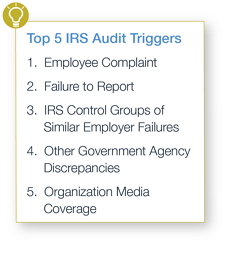An excerpt from the HUB International webinar.
Over the last six years, the Affordable
Care Act (ACA) has dramatically changed the employee benefits landscape across
the country for employers and employees alike. High deductible health care
plans (HDHPs) and health savings accounts (HSAs) have replaced traditional co-pay
plans. The so-called “Cadillac” plans are harder to come by and voluntary
benefits have popped up everywhere to plug in the gaps. As the first year of
ACA reporting deadlines have just passed, the first wave
of IRS audits, as specified in the ACA, will begin.
The government views the ACA as a huge
revenue source and they have pushed a lot of their resources toward the audit
arm. The federal agencies are becoming quite aggressive, especially
when it comes to protecting participants, as they are charged by law to have
regular enforcement efforts.
 There are a
number of triggers that will prompt ACA audits, including:
There are a
number of triggers that will prompt ACA audits, including:
- Employee
complaints
– Regardless of the credibility or level of severity, employee complaints will
be taken very seriously
- Reporting
failures
– This year, while leniency will be granted on inaccuracy because the laws
are new, failures in reporting will still pose a red flag.
- Failures of IRS Control Group
employers – The
IRS is putting similar businesses into control groups. Where they see one
business failing, they are assuming similar businesses will fail in the same
way.
- Other
agencies identifying issues – Agencies like the Department of
Labor (DOL) and the Internal Revenue Service (IRS) will have a cross-referral
agreement where they are required to share information about businesses
not in compliance, thus triggering audits from multiple agencies.
- Media
reports
– Media coverage on an organization’s business and employee practices could
raise suspicion with regulators as well and trigger an audit.
Mitigating
the risk of an audit
While you may not be able to totally avoid
every trigger. The antidote to dodging a full fledged audit is to
keep good records.
Your documentation is key to both
avoiding and surviving an audit. That means protecting yourself with proper and
adequate documentation and working toward consistent administration.You’re not alone if you’re not perfect at it, but working toward
consistency is the ultimate goal.
HUB suggests six best practices that,
when adopted, can help any organization look their best daily in the face of a potential
audit. They include:
- Document
good faith compliance on questionable issues/gray areas. This
includes reviewing and adopting corresponding wording in all internal and
employee-facing materials. Retain a benefits file, document that you’ve
treated everyone fairly and how you interpreted and made decisions when it
comes to gray areas of the law.
- Compliance
review. Focus
on administrative practices and make sure they are in compliance. Review
all third-party agreements – remember, questionable business practices of
vendors and businesses you associate with could trigger an investigation
of your organization.
- Correct
failures found.
Make sure administrative processes are in order, and when you discover an
issue, hold internal compliance discussions to correct your failures.
- Designate
employee status. Create realistic benefits expectations
for employees by communicating their employee status and eligibility.
- Develop
a multi-year benefits plan. Thoughtful plan design and
consideration of its impact on affordability, compliance and
administration will facilitate compliance.
- Train
managers.
Beware of practices to terminate or limit hours for employees to prevent
them from eligibility levels. Understand
the law and work within it for hiring, firing and scheduling practices.
If your business is subject to an audit, knowing what it will look like
and how to handle it will be key to passing with flying colors. Be prepared
with the right documentation and proof. Contact
your HUB
employee benefits advisor to help maintain compliance and minimize your risk of
an ACA audit.